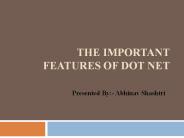NeT - PowerPoint PPT Presentation
1 / 18
Title:
NeT
Description:
... X) will be combined to one tuple. Observation: We need to ... Future Work. 1997. B2. 1994. B1. Year. Btitle. 2002. A1. Year. Atitle. A1. Null. 25. P4. A1. Null ... – PowerPoint PPT presentation
Number of Views:23
Avg rating:3.0/5.0
Title: NeT
1
NeT CoT Translating Relational Schemas to
XML Schemas
- Dongwon Lee, Murali Mani,
- Frank Chiu, Wesley. W. Chu
2
Outline
- Problem Definition and Motivation
- NeT Translation using the nest operator in
Nested Relational Algebra - CoT Translation using foreign key constraints
between tables - Conclusions and Future directions
- Important References
3
What are we studying?
Sname Advisor Since
MM Muntz 1998
YC Muntz 2000
Pname Age
Muntz 61
ltprofessor PnameMuntz Age61gt ltstudent
SnameMM Since1998/gt ltstudent SnameYC
Since2000/gt lt/professorgt
4
Why do we study this?
- Data exchange - XML has established itself as the
standard format for data exchange between
applications. - Data integration and better data model - XML
views of relational data are oftentimes easier to
use, and also helps in data integration of
multiple data sources.
5
NeT Using the Nest operator
course ? (Cname, Prof, Text)
Cname Prof Text
Algorithms Gafni Udi Manber
Algorithms Gafni CLR
Algorithms Majid Udi Manber
Algorithms Majid CLR
6
NeT (contd)
course ? (Cname, Prof , Text)
Cname Prof Text
Algorithms Gafni, Majid Udi Manber
Algorithms Gafni, Majid CLR
course ? (Cname, Prof , Text )
Cname Prof Text
Algorithms Gafni, Majid Udi Manber, CLR
7
NeT (contd)
person ? (Name, City, State, Zip)
Name City State Zip
MM Los Angeles CA 90034
AN Los Angeles CA 90034
person ? (Name, City, State, Zip)
MM, AN Los Angeles CA 90034
8
NeT Formal Definition
- Consider Table t with column set C. Nesting on
column X is defined as - Any two tuples with the same values for
- (C X) will be combined to one tuple
- Observation We need to nest only on key columns
9
CoT Using foreign key constraints
Sname Advisor CName
MM Muntz DBs
YC Muntz DBs
YC Muntz QSs
Pname Age
Muntz 61
professor ? (Pname, Age, student) student ?
(Sname, Cname)
ltprofessor PnameMuntz Age61gt ltstudent
SnameMM CnameDBs/gt ltstudent SnameYC
CnameDBs/gt ltstudent SnameYC
CnameQSs/gt lt/professorgt
10
CoT (contd)
Sname Advisor Cname
MM Muntz DBs
YC Muntz DBs
YC Muntz QSs
Pname Age
Muntz 61
Cname Since
DBs 1979
QSs 1962
professor ? (Pname, Age, student) student ?
(Sname, Ref_course) course ? (Cname, Since,
ID_course)
11
CoT (contd)
ltprofessor PnameMuntz Age61gt ltstudent
SnameMM Ref_courseDBs/gt ltstudent
SnameYC Ref_courseDBs/gt ltstudent
SnameYC Ref_courseQSs/gt lt/professorgt ltcourse
CnameDBs Since1979 ID_courseDBs/gt ltcours
e CnameQSs Since1962 ID_courseQSs/gt
12
CoT algorithm
student
proj
prof
emp
course
dept
Top nodes
13
Conclusions
- Better data model for the user to work with.
- Constraints are maintained.
- Reduced data redundancy from NeT and CoT backed
by experiments on UCI-KDD repository and TPC-H
data. - Implemented and available for use.
14
Lessons Learnt
- Helped us learn key issues in XML data modeling
- Local Tree Grammars (such as DTD) sufficient for
these applications - The resulting XML Schema did not have any
recursion
15
Future Work
Btitle Year
B1 1994
B2 1997
Name Age Book Article
P1 64 B1 Null
P2 52 B2 Null
P3 31 Null A1
P4 25 Null A1
Atitle Year
A1 2002
book ? (Btitle, Year) article ? (Atitle,
Year) person ? (Name, Age, Book, Article)
16
Future Work (contd)
If we knew book.person ? article.person ?
book.person ? article.person person
book ? (Btitle, Year, person) article ? (Atitle,
Year, person) person ? (Name, Age)
17
Future Work (contd)
Name Age Mgr
A 25 M
B 31 M
M 61 Null
ltperson NameM Age61gt ltperson NameA
Age25/gt ltperson NameB
Age31/gt lt/persongt
18
References
- Taxonomy of XML Schema Languages using Formal
Language Theory, M. Murata, D. Lee, M. Mani,
Extreme Markup Languages 2001 - Semantic Data Modeling using XML Schemas, M.
Mani, D. Lee, R. R. Muntz, ER 2001































